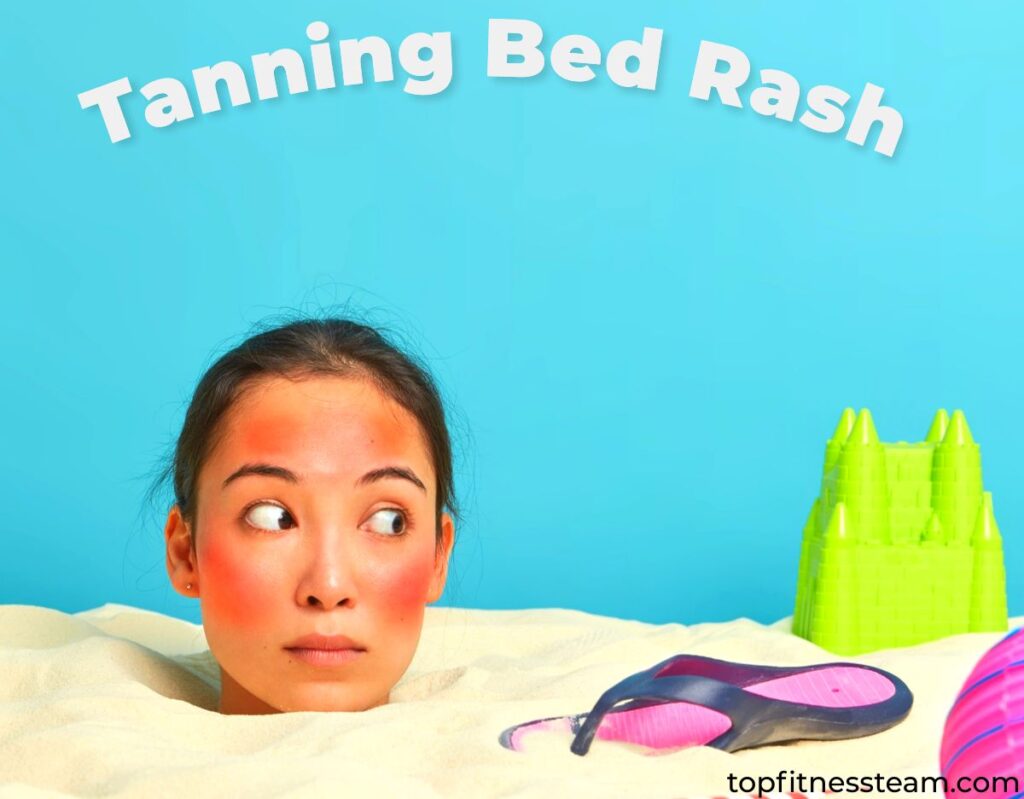Hello everyone, Top Fitness Team is here. I will tell you about Tanning Bed Rash In this article.
Introduction
Introduce the topic of tanning, highlighting the popularity of indoor tanning in salons. Say the possible side effects of tanning beds, such as allergic reactions, skin cancer, and rash.
Include a statement on the importance of knowing the difference between UVA and UVB rays and how they can affect the skin. Briefly touch on ways to prevent tanning bed rash and when to seek medical attention.
Understanding UV Rays
Explain what UV rays are, including UVA and UVB, and how they are used in indoor tanning.
Describe the effects of UV radiation on the skin, mainly how it can cause a rash from tanning.
Include the risks of prolonged exposure to UV light, such as skin cancer and skin irritation conditions. Highlight the importance of proper UV protection in the tanning salon.
Recognizing and Treating
Describe the rash signs from tanning, including the affected area, itching, and pain.
Offer solutions like cold compresses, aloe vera gel, and other home remedies.
Emphasize the importance of seeking medical alert if symptoms persist. Discuss the difference between heat rash and other skin conditions.
What are the causes of a tanning bed rash?
It is a common skin issue many people may experience after using a tanning bed. So, what causes tanning bed rash?
A variety of factors generally cause the rash. The UV radiation from the UV lamps, including both UVA and UVB rays, can irritate the skin, particularly if the exposure is extended or the skin is exposed.
This rage might be displayed as redness, itching, or trim spots on the affected area.
Using tanning lotions that do not suit the person’s skin type can lead to an allergic reaction, presenting to the rash.
Lack of cleanliness in the tanning salon or the bed itself may lead to bacteria or fungi, which can also cause rash.
Overexposure to UV light during a tanning session may dry out the skin, showing a condition equal to heat rash.
Finally, the individual’s skin type and sensitivity to UV light are essential in how the skin will react to tanning.
By understanding these factors, people can take the necessary protection to minimize the chance of developing a tanning bed rash and enjoy a more lovely tanning experience.
Choosing the Right Tanning Lotions
Discuss the role of tanning lotions in improving the tanning session while highlighting possible allergic reaction risks.
Show guidance on the proper effects to stop tanning bed rash and avoid skin irritation.
Mention options for traditional tanning lotions.
Prevention and Care
Provide tips to control tanning beds, such as following guidelines from the tanning salon, using UV protection, and knowing the limits of UV direction.
Suggest home remedies like aloe vera gel for soft skin upset after a tanning session.
It is essential to understand the side effects of UV radiation.
Alternatives to Indoor Tanning
Discuss alternatives to indoor tanning that might reduce the chance of skin cancer, rash from tanning, and other damaging side effects.
Reach the dangers and benefits of different choices.
Include “Does Planet Fitness Have Personal Trainers?” for readers interested in fitness and beneficial lifestyle choices.
Pros And Cons
Pros of Tanning Bed Rash:
- Highlights overexposure risks early.
- Promotes safer tanning habits.
- Signals needed for skin care.
- Indicates bed cleanliness issues.
- This can lead to professional consultation.
Cons of Tanning Bed Rash:
- Causes skin discomfort and itching.
- Potential precursor to damage.
- Aesthetically unpleasing red patches.
- Increases skin infection risk.
- Hinders even tanning results.
My Final Thoughts
Outline the key points of the blog, focusing on the importance of awareness about UV rays, understanding the risks of skin cancer, and taking proper measures to prevent tanning bed.
Prompt readers to be bold in caring for their skin and to seek medical attention if they notice any concerning symptoms. Repeat the availability of alternative tanning methods and promote safe practices.
FAQs
Q: What does a sunbed rash look like?
Ans A sunbed rash typically appears as red, itchy bumps or patches on the skin. It may be attended by dryness or peeling and usually grows in areas uncovered to UV light.
Q Can tanning bed cause an itchy rash?
Ans Yes, tanning beds can cause an itchy rash. UV radiation can irritate the skin, significantly leading to redness and itchiness if the direction is extended or the skin is sensitive.
Q What rash is caused by tanning?
Ans The rash caused by tanning, often referred to as tanning bed, includes signs like redness, itchiness, and small bumps. It can be induced by UV radiation, allergic reactions to lotions, or unclean tanning beds.
Q: Can tanning beds cause skin problems?
Ans Yes, tanning beds can cause skin problems, including early aging, dryness, allergic reactions, and an increased risk of skin cancer. Long-term exposure to UV rays is incredibly concerning.
Q: How do you treat bed rash?
Ans Treatment for bed rash can be addressed with cold compresses, aloe vera gel, or over-the-counter creams. If symptoms persist or worsen, seeking medical attention is advised for proper care and treatment.
Thanks.
